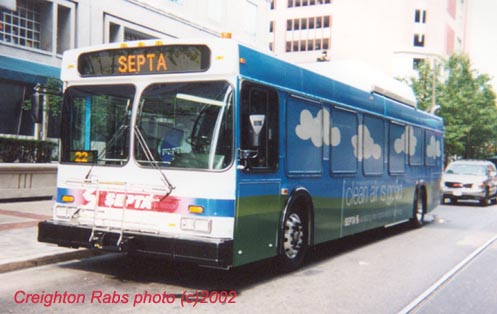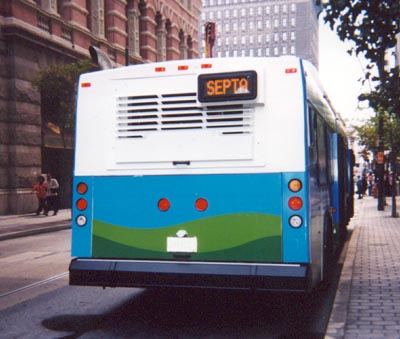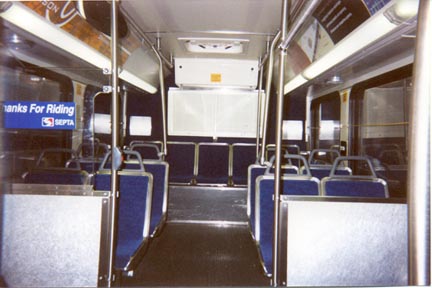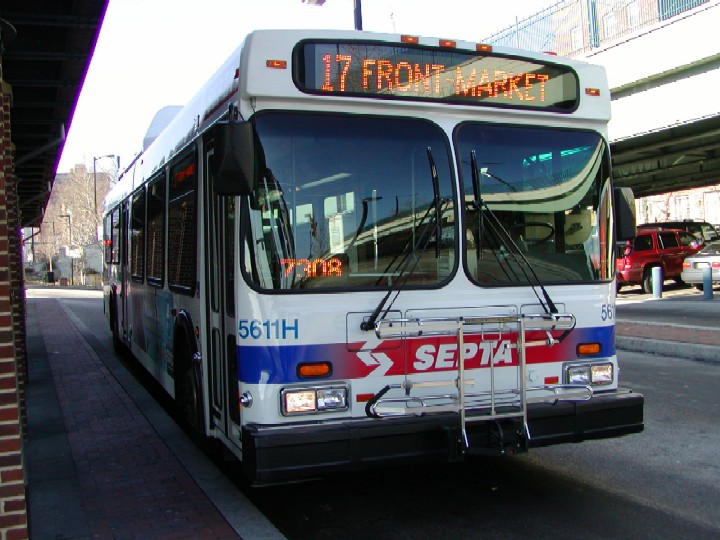




Details about how the system works from a SEPTA Staff Summary dated June 26, 2000:
The major difference between the Hybrid bus and the standard diesel bus is the drive system. The drive system is a complete propulsion system integrating an AC drive motor with a traction control system to propel and recover braking energy from the wheels, a battery pack, and a power generation system. The power generation system replaces the engine/transmission combination with a constant speed small diesel powered engine and generator. The constant speed diesel engine and generator system reduces fuel consumption and emissions.
More details about the hybrid system from a SEPTA Staff Summary dated July 22, 2003:
As part of their initial proposal, New Flyer proposed an Allison series type drive system which had been undergoing testing as part of New Flyer's Hybrid demonstration projects being conducted in Orange County, California and Portland, Oregon. Concurrently, with the ongoing testing of this series Hybrid technology, Allison was developing a second Hybrid drive system called a parallel drive system. this technology differs from the series Hybrid drive in that the parallel drive utilizes a mechanical connection of the engine to the drive axle in addition to the electric drive. Through lab testing, the efficiency of the parallel drive system was demonstrated primarily due to its capability to blend electrical and diesel power to the drive power through various ranges of vehicle operation. In the series drive system, this mechanical connection does not exist. Instead, the diesel engine is connected to a generator that provides electricity to an inverter which in turn, either charges stored batteries or drives an AC motor that is connected to the drive line.
As a result of the advanced technology that has been incorporated in the parallel Hybrid drive and its resultant superior performance, Allison is no longer offering the series Hybrid drive. The decision by New Flyer and supported by SEPTA, not to utilize this type of system was a sound one. If SEPTA required New Flyer to stay with the series drive system, the Hybrid bus would have been an obsolete system no longer manufactured by the supplier.
After the Allison parallel drive system was developed and tested, Allison made the decision to commit all their resources to that system. The series drive system is no longer available from Allison. New Flyer proposed SEPTA switch to the Allison parallel drive system in March 2002. SEPTA accepted the parallel drive offer based on the advantages of the system and New Flyer committment to provide a state of the art drive system. In June 2002, Allison informed SEPTA that the design of the parallel drive unit had been "frozen". The pilot Hybrid buses (5601H and 5602H) were delievered to SEPTA in the fall of 2002 with parallel drives as "Engineering Validation" units by Allison Transmission. Engineering Validation units are built by hand. Allison was preparing to build limited production drives known as "Production Validation" units. This required manufacturing set-up that would delay delivery of drive units to New Flyer until July 2003.
The replacement of the series drive system with the parallel drive system has been accepted by SEPTA. It is coincidental that the SEPTA contract was awarded on the cusp of evolving Hybrid propulsion technology. New Flyer believes that it is in the interest of both SEPTA and New Flyer, that the best technology be made available even though additional time is needed to complete delivery and that there should not be any cost impact due to this later delivery.
Specifications are taken from a flyer handed out at in October 2002.
Passenger Amenitites:
Physical/Technical Data:

Comments about this page can be emailed to ctrabs74@yahoo.com.
